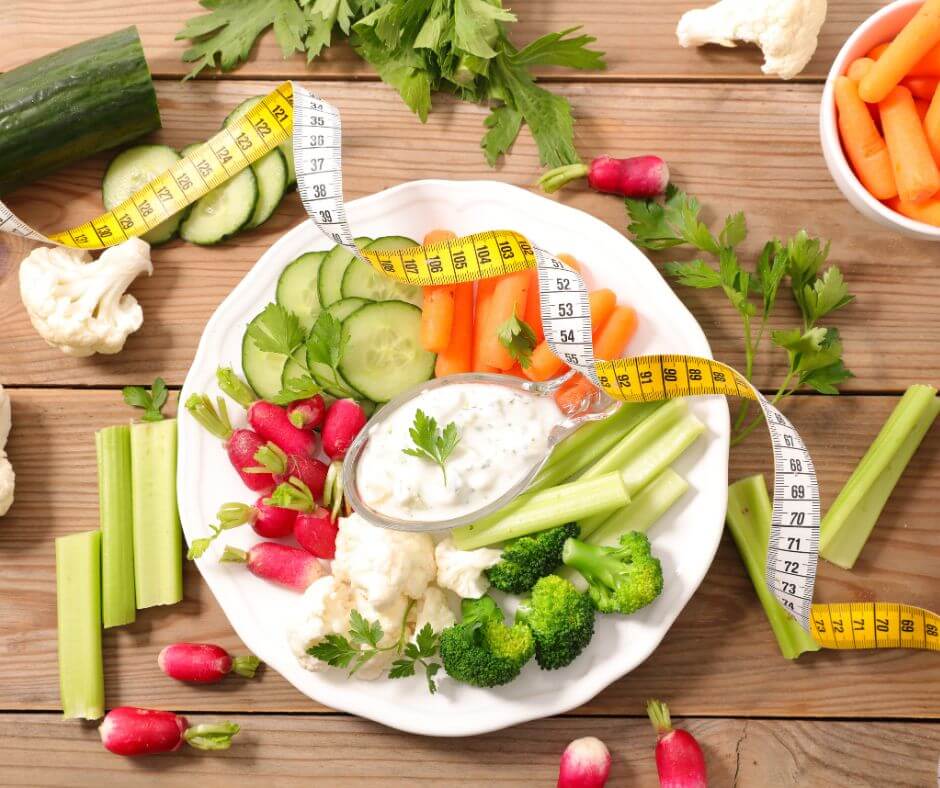How much veg should i eat a day ? many people are often confused about how much vegetable intake is necessary to meet their daily nutritional requirements. In this blog, we will discuss the importance of vegetables in our diet and provide a comprehensive guide on how much veg you should eat daily.
We will explore the recommended daily serving sizes for different age groups, genders, and lifestyles and the health benefits of meeting these recommendations.
If you are a picky eater, a busy professional, or someone who wants to improve their eating habits, we will help you make informed decisions about your vegetable intake and maintain a healthy and balanced diet.
Importance of vegetable intake in our diet:

A healthy diet must include plenty of vegetables. They are brimming with the vitamins, minerals, and nutrients our bodies require to function correctly. Here are some reasons why vegetable intake is so important:
Nutritional benefits:
Vegetables are low in calories and high in fiber, which can help you maintain a healthy weight and keep your digestive system healthy also rich in nutrients such as vitamin C, vitamin A, folate, and potassium.
Disease prevention:
Eating enough vegetables can reduce the risk of chronic diseases such as heart disease, stroke, and certain types of cancer. This is because vegetables contain antioxidants and other compounds that can protect against cellular damage and inflammation.
Improved digestion:
The fiber in vegetables can help keep your digestive system healthy and prevent constipation. Additionally, fibre lowers cholesterol and controls blood sugar.
Healthy aging: As we age, our bodies require more nutrients to stay healthy. Vegetables are an excellent source of vitamins and minerals that can support healthy aging and prevent age-related diseases.
The confusion around how much veg we should eat daily:

Despite the importance of vegetables in our diet, there is often confusion about how much we should be eating on a daily basis. This confusion can stem from a variety of factors, including conflicting dietary guidelines, individual dietary preferences, and cultural differences.
Here are some common sources of confusion when it comes to vegetable intake:
Conflicting dietary guidelines:
Different countries and organizations may have different dietary guidelines when it comes to vegetable intake. For example, the United States Department of Agriculture (USDA) recommends that adults eat 2-3 cups of vegetables per day, while the World Health Organization (WHO) recommends that adults eat at least 400 grams (about 14 ounces) of vegetables per day.
Individual dietary preferences:
Some people simply don’t enjoy eating vegetables or have limited access to fresh produce. This can make it difficult to meet daily vegetable intake recommendations.
Cultural differences:
Different cultures may have different dietary habits and preferences when it comes to vegetables. For example, some cultures may eat a lot of leafy greens, while others may focus more on starchy vegetables like potatoes and corn.
Recommended serving sizes for different age groups:

The recommended daily serving sizes for vegetables can vary depending on your age, gender, and activity level. Following are some general recommendations according to age and gender:
Children:
The American Academy of Pediatrics recommends that children ages 2-3 eat 1 cup of vegetables per day, while children ages 4-8 should eat 1.5 cups of vegetables per day.
Adults:
The USDA recommends that adults eat 2-3 cups of vegetables per day, with a focus on consuming a variety of different types and colors. For example, aim to eat at least 1.5 cups of dark green vegetables (such as spinach or broccoli) and 1.5 cups of red and orange vegetables (such as carrots or sweet potatoes) per week.
Pregnant and breastfeeding women:
Pregnant and breastfeeding women should aim to consume at least 2.5 cups of vegetables per day, including leafy greens and other sources of folate.
Older adults:
Our bodies need more nutrients as we get older in order to sustain good health. The National Institute on Aging recommends that older adults aim to eat at least 1.5-2 cups of vegetables per day, with a focus on consuming a variety of colors and types.
How lifestyle factors can impact recommended intake:

Lifestyle factors such as activity level, body size, and health status can impact the recommended vegetable intake for an individual. Here are some examples:
Activity level:
Individuals who engage in regular physical activity may require more vegetables to support their energy needs and muscle recovery. Athletes, for example, may require more than the recommended daily intake of vegetables to meet their nutritional needs.
Body size:
Larger individuals may require more vegetables to maintain a healthy weight and support their metabolism. Smaller individuals may require fewer vegetables to meet their nutritional needs.
Health status:
Individuals with certain health conditions may require more or fewer vegetables in their diet. For example, individuals with high blood pressure or heart disease may benefit from consuming more potassium-rich vegetables like spinach and broccoli, while individuals with kidney disease may need to limit their intake of certain vegetables.
Dietary preferences:
Some individuals may have dietary preferences or restrictions that impact their vegetable intake. For example, vegetarians or vegans may need to consume more vegetables to meet their protein needs, while individuals with food allergies or intolerances may need to avoid certain vegetables.
Nutritional benefits of some vegetables:
| Vegetable | Nutritional Benefits |
|---|---|
| Spinach | Rich in iron, calcium, vitamin A, vitamin C, and folate. May improve blood glucose control and reduce risk of cancer and heart disease. |
| Broccoli | Rich in vitamin C, vitamin K, vitamin A, folate, and potassium. May reduce inflammation and protect against cancer and heart disease. |
| Carrots | Rich in beta-carotene, vitamin A, vitamin C, fiber, and potassium. May improve blood glucose control and reduce the risk of cancer and heart disease. |
| Sweet potatoes | Rich in lycopene, vitamin C, vitamin K, and potassium. May reduce the risk of cancer and heart disease. |
| Tomatoes | Rich in iron, calcium, vitamin A, vitamin C, and folate. May improve blood glucose control and reduce the risk of cancer and heart disease. |
| Bell peppers | Rich in beta-carotene, vitamin A, vitamin K, potassium, and fiber. May improve eye health and reduce the risk of cancer and heart disease. |
| Kale | Rich in vitamin C, vitamin A, vitamin K, and potassium. May improve eye health and reduce the risk of cancer and heart disease. |
| Brussels sprouts | Rich in vitamin C, vitamin K, folate, and fiber. May reduce inflammation and protect against cancer and heart disease. |
| Cauliflower | Rich in vitamin C, vitamin K, folate, and fiber. May reduce inflammation and protect against cancer and heart disease. |
| Green beans | Rich in vitamin C, vitamin K, folate, and fiber. May improve digestive health and reduce risk of cancer and heart disease. |
How sufficient vegetable intake can reduce the risk of chronic diseases:

Consuming sufficient amounts of vegetables has been linked to a reduced risk of chronic diseases. Here are some examples:
Cardiovascular disease:
Vegetables contain nutrients such as potassium, fiber, and antioxidants that can help lower blood pressure, reduce inflammation, and improve cholesterol levels, all of which are risk factors for cardiovascular disease.
Cancer:
Some vegetables contain compounds called phytochemicals, which have been shown to have anti-cancer properties. Additionally, the fiber in vegetables can help promote a healthy digestive system and reduce the risk of colon cancer.
Diabetes:
Eating a diet rich in vegetables can help improve blood glucose control, which is important for individuals with diabetes. Vegetables are also low in calories and high in fiber, which can help with weight management, another important factor in diabetes prevention.
Obesity:
Vegetables are low in calories and high in fiber, which can help promote satiety and prevent overeating. Additionally, consuming a diet rich in vegetables can help reduce inflammation in the body, which has been linked to obesity and related health problems.
The importance of variety in vegetable consumption:

Eating a variety of different types and colors of vegetables is important for overall health and nutrition. Here are some reasons why:
Nutrient diversity:
Different vegetables contain different nutrients. By consuming a variety of vegetables, you can ensure that you are getting a wide range of vitamins, minerals, and phytochemicals that are important for health.
Flavor and enjoyment:
Eating the same vegetables every day can become boring and may decrease your enjoyment of healthy eating. By mixing it up and trying new vegetables, you can discover new flavors and textures that make healthy eating more enjoyable.
Antioxidants and phytochemicals:
Vegetables contain a variety of antioxidants and phytochemicals that have health benefits, such as reducing inflammation, protecting against cancer, and promoting healthy aging. Different types of vegetables contain different types of these beneficial compounds, so it’s important to eat a variety.
Fiber intake:
Eating a variety of vegetables can also help increase your fiber intake, which is important for digestive health, weight management, and reducing the risk of chronic diseases such as heart disease and diabetes.
Tips for picky eaters:

If you or someone you know is a picky eater, it can be challenging to incorporate enough vegetables into the diet. The following advice will help make eating vegetables more pleasurable:
Start small:
If you are not used to eating vegetables, start with small portions and gradually increase over time. This can help your taste buds adjust to the new flavors and textures.
Experiment with different cooking methods:
Different cooking methods can greatly impact the flavor and texture of vegetables. Try roasting, grilling, sautéing, or steaming to see which method you prefer.
Add a flavor:
Vegetables can be seasoned with herbs, spices, and other seasonings to add flavor. Try garlic, ginger, cumin, or rosemary to add a new dimension to the taste.
Hide vegetables in other dishes:
If you are still struggling to eat vegetables on their own, try adding them to other dishes. For example, blend spinach into a smoothie or add grated carrots to spaghetti sauce.
Make it fun:
Cut vegetables into fun shapes, use dip, or create a colorful vegetable platter to make eating vegetables more fun and enjoyable.
Involve children:
If you have children who are picky eaters, involve them in the process of choosing and preparing vegetables. They feel more invested in the process as a result which encourages them to try new foods.
Ways to incorporate vegetables into your busy lifestyle:

Incorporating vegetables into your diet can be challenging, especially if you have a busy lifestyle. Here are some suggestions to help:
Meal prep:
Set aside time at the beginning of the week to chop and prepare vegetables for the week ahead. This can save time during the week and make it easier to incorporate vegetables into meals.
Quick and easy snacks:

Keep raw vegetables on hand for quick and easy snacks. Carrot sticks, celery, and cherry tomatoes are all easy to prepare and can be eaten on the go.
Smoothies:
Smoothies are a terrific way to increase your daily intake of vegetables.. Add spinach, kale, or other leafy greens to your smoothie along with fruit for a delicious and nutritious drink.
Salads:
Adding vegetables to your diet is simple with salads. Preparing a large salad at the beginning of the week and portioning it out for lunches can be a time-saving option.
Veggie omelets:
Adding vegetables to omelets is an easy and delicious way to get more vegetables into your diet. Add chopped peppers, onions, and spinach for a tasty and nutritious breakfast.
Vegetable soups:
Soups are an easy way to incorporate a variety of vegetables into your diet. Prepare a large batch of vegetable soup and freeze it in individual portions for a quick and healthy meal option.
Stir-fries:
Stir-fries are a quick and easy way to incorporate vegetables into your diet. Chop up a variety of vegetables and stir-fry them with lean protein and a tasty sauce for a nutritious and flavorful meal.
Creative recipe ideas for vegetable-centric meals:

Here are some creative recipe ideas for vegetable-centric meals that are delicious and nutritious:
Vegetable stir-fry:
Stir-fry is a great way to use up a variety of vegetables. Combine broccoli, carrots, bell peppers, snap peas, and other vegetables of your choice with a protein of your choice (such as tofu or chicken) and a flavorful sauce. Serve over noodles or rice for a filling supper.
Zucchini noodles:
Use a spiralizer to create zucchini noodles, then toss them with a flavorful sauce and toppings such as cherry tomatoes, mushrooms, and Parmesan cheese.
Stuffed peppers:
Cut the top off of bell peppers and remove the seeds and membranes. Stuff the peppers with a mixture of cooked quinoa, diced tomatoes, black beans, corn, and spices. Bake in the oven until the filling is thoroughly heated and the peppers are soft.
Cauliflower rice:
Pulse cauliflower in a food processor until it resembles rice, then sauté it with garlic, onion, and your choice of vegetables. Serve as a side dish or use as a base for a grain-free stir-fry.
Sweet potato tacos:
Roast sweet potato cubes until tender, then serve them in warm corn tortillas with black beans, diced avocado, salsa, and a squeeze of lime juice.
Lentil soup:
Cook lentils with vegetables such as carrots, celery, and onion in vegetable broth until tender. Add spices such as cumin and coriander for flavor.
Vegetable frittata:
Eggs and sautéed vegetables like zucchini, bell peppers, and onion are combined in a bowl. Slice into wedges after baking in the oven until done.
Thoughts and encouragement to prioritize vegetables in your diet:
Incorporating more vegetables into your diet can be challenging, but the benefits are well worth the effort. Vegetables are packed with nutrients that are essential for good health, such as fiber, vitamins, and minerals. Eating a variety of vegetables can help reduce your risk of chronic diseases such as heart disease, diabetes, and certain types of cancer.
It’s easy to get caught up in our busy lives and prioritize convenience over nutrition, but making a conscious effort to include more vegetables in our meals can make a big difference in our health and well-being. Remember, every little bit counts, so even if you can only manage to add one serving of vegetables to your meals each day, it’s a step in the right direction toward a healthier diet.
Make it a priority to incorporate more vegetables into your meals creative with your recipes try new vegetables and experiment with different cooking methods. Long-term benefits include your body thanking you for it.













